Kalguksu (Korean Knife Cut Noodle Soup) is light yet comforting and satisfying noodle soup. It’s perfect for a cold wintery day but also a popular summer dish for many in Korea. I share how to make your own incredible homemade Kalguksu 칼국수 noodles that are perfectly chewy and yummy. They are also a great fun activity to do with your family!

What is Kalguksu 칼국수?
Kalguksu literally means ‘knife noodles’ but in general it refers to hot noodle soup made with wheat flour noodles that were handmade and cut with a knife. Records go back all the way to the Goryeo era and at which time wheat was very expensive.
Not much is needed to make these noodles – just your hands, muscle power, a rolling pin and a knife. Although making your own fresh noodles is a bit of extra work, it’s well worth the effort – you can get chewier, lighter and thinner noodles.
When we were grad students in Florida in the early 90’s, there was no way to buy fresh noodles from the Korean market as you can now. So we made our own almost every weekend during cooler weather. And this was one cooking activity my husband loved to help.
BTW, my husband helped me again with the kneading and the dough for this post. He wants to make sure I let you all know that he helped. You know him by now.. he loves to be in the spotlight – unlike me…hahaha. Back then, he really didn’t want to help with cooking very much. But our deal was that if he made the noodles (because making the dough was too hard on my arms 😝), I was willing to make the noodle soup.
He would always say – “Oh, yes, I am good with things that need muscle power!”💪🏻💪🏻
Between you and me, it really doesn’t need that much power… 😉😜sssh… but I let him believe it.. lol.
Kalguksu (Korean Knife Cut Noodle Soup) Variations
This noodle soup comes in quite a few different versions based on the type of broth and toppings. Different regions also have different variations. The version I have here is somewhat of a mix between Myeolchi and Seoul style Kalguksu which is usually topped with beef and zucchini. Here is a quick list of different variations:
- Andong Style(안동국시 Andong Guksi) – This is referred to as the original form of Kalguksu. Andong (read more on my visit here) is known for their refined cuisine developed for nobilities and so the noodle soup developed here has naturally moved up to Seoul and became popular int he 80’s. The dough for the noodles usually mixes in soybean powder with the flour to make a more flavorful noodle.
- Seoul style – similar to Andong style, I’m calling this Seoul style for a lack of a better name. It is usually has a mixed broth of anchovies and beef. Bone broth can even be used sometimes and has beef and zucchini toppings. This is most similar to our family-style except I usually don’t mix in beef broth.
- Dak Kalguksu (닭칼국수) – Dak means chicken and so this is knife-cut noodles served in chicken broth with chicken meat as a topping. A great way to make this is to first enjoy some Baeksuk, then use the leftover soup and meat to make this dish.
- Bajirak Kalguksu (바지락칼국수) – Bajirak are clams and so the broth is made using clams as the main ingredient. If you love clams, it’s a must try in the Jeolla province.
- Haemul Kalguksu (해물칼국수) – Haemul = seafood. Here you can create your own mix of seafood like crabs, clams, squid and more to make the broth and then cook noodles with it. Of course, these are more popular in seaside regions.
Besides these, there is one using Perilla seed powder (ddeulkkae 들깨), one with Maesaengyi 매생이 (type of seaweed) which are usually popular around seaside towns, and even a spicy one called Eolkeunyi 얼큰이 Kalguksu which is made by adding gochujang and gochukaru to anchovy broth.
What’s special about my Kalguksu dough
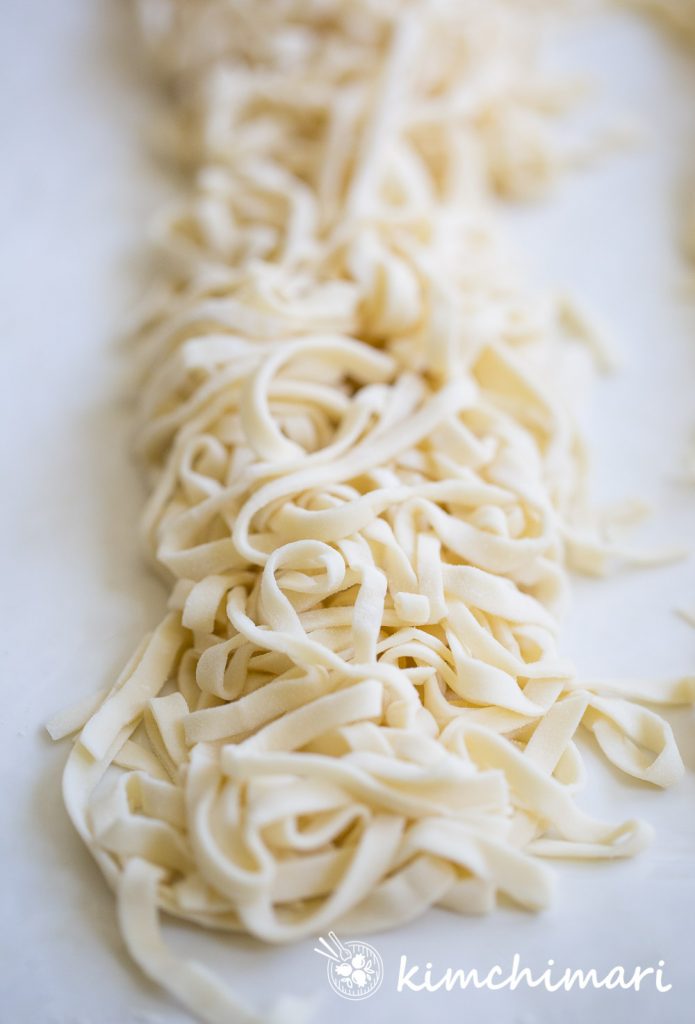
If you look around, most knife cut noodle recipes will tell you to use 3:1 = flour:water ratio. Some recipes even add oil which means there’s even more liquid. I tried that ratio and also recipes that use added oil and personally, I find the 3:1 flour to water ratio produces too soft a dough which is not only harder to handle but also produces less chewy noodles.
By saying that it’s ‘harder to handle’, I mean that the 3:1 dough will easily lump up together after you cut the noodles instead of separating.
The drier the noodles are, it will be chewier and thinner as you can roll out more thinly. But if you prefer a softer noodle and even prefer thicker noodles, you can certainly add more water or just do 3:1 ratio and that should work fine too.
Chef’s Tips for Perfect Korean Kalguksu
- EAT IT RIGHT AWAY – The flour noodles will quickly absorb the liquid so start cooking the noodles ONLY when everyone is ready to eat and at the table!
- Make with Different Broths – Anchovy broth is my favorite but you can make this noodle soup in beef broth (gogiguk recipe), chicken broth (use leftover baeksuk meat and soup) and seafood broth (add clams, crab, mussels before adding noodles to basic anchovy broth).
- Make noodles and broth ahead – you can make noodles up to a day ahead by refrigerating the dough and the broth days ahead. Read my Anchovy Broth recipe.
- Don’t overcook your fresh homemade noodles – depending on how thin or thick you rolled out the dough, it will take about 3 minutes (for my very thin noodles in the pic) to 5 minutes. Close to 3 minutes if you want al dente style and cook longer if you like softer noodles.
- Best store-bought noodles – My favorite ready-made fresh noodles are Pulmuone noodles (pic below) and they need to be cooked 5-6 minutes.
- Other vegetables to add – carrots and potatoes are some common additions besides zucchini
- Storing freshnoodles – refrigerate dough up to a day ahead and leftover noodles can be stored too but make sure they are dried for 1/2 day and well-floured so they don’t stick together.
Step-by-Step Instructions
How to make knife-cut noodles (skip this if you are using store-bought)
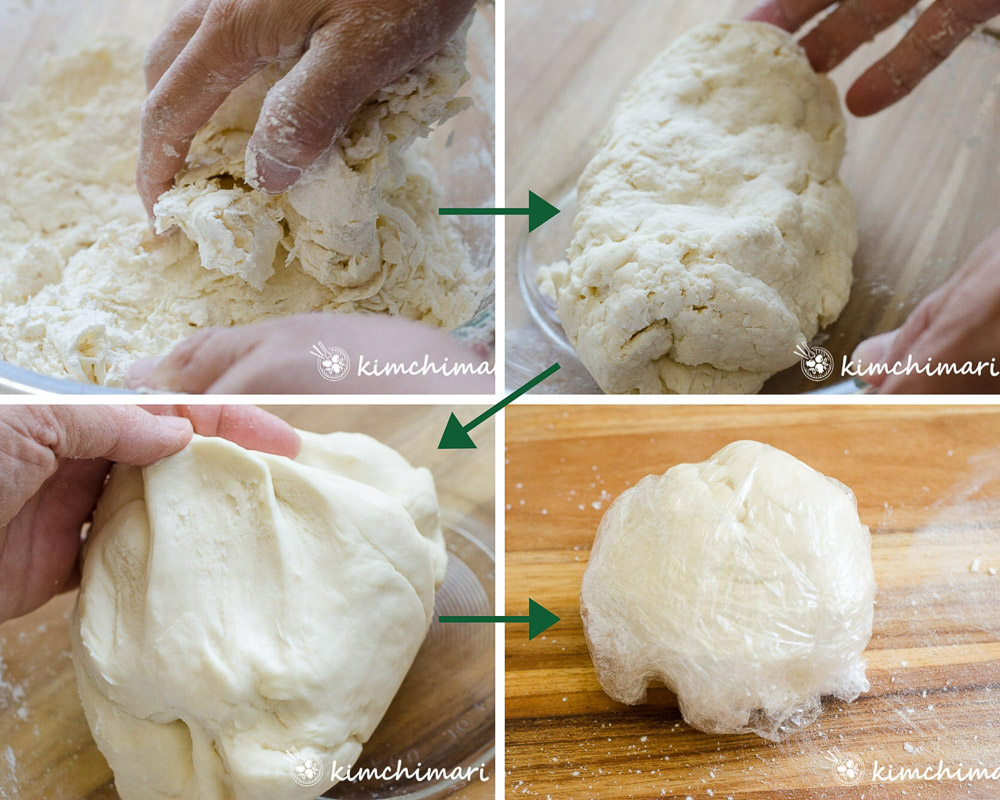
- In a bowl, mix flour, salt and water with a spatula and then use your hands to form a ball. Making sure all the flour is incorporated into the dough.
- My recipe uses less water than most recipes so it may feel like there isn’t enough water. The exact amount can change based on how dry your flour is but start with 1/4 cup + 1.25 tsp water per 1 cup of flour and see if you are able to form a dough. If not, knead for a few times to before adding water because it may feel wetter once you knead.
- Sprinkle some flour on a counter or a board and then transfer the ball onto it. Knead a few times to make sure it forms one uniform dough.
- Wrap with a plastic wrap or put in a plastic bag and let it rest for 30 minutes or more. Surface should be nice and smooth.
How to make noodles for Kalguksu - When it has rested, take out the dough and knead for 2 minutes to warm up the dough. On a floured surface, roll out the dough using a rolling pin until it is about 10×10 inch square or 8×11 rectangle.
- Square or rectangle doesn’t matter as long as the thickness is around 1/8th inch thick or even thinner. I rolled ours to about 1/8 th thick. If the dough is sticky, sprinkle some flour on the rolling pin and on the board while rolling. Roll out until it’s nice and thin – like you see in the picture.
- Sprinkle flour on the surface of the dough (so it doesn’t stick to itself when rolled up) and fold the dough over from one side 4-5 times so you have layers. (see 2,3 in pic below)
- Cut gently with a knife (if you press hard quickly, they will get smooshed so cut gingerly) into 1/4 inch wide cuts and immediately unfold and loosen the layers. If you leave it too long, they will stick to each other.
- Once unfolded, sprinkle more flour on noodles and toss them so they stay separated. Set aside until you are ready to cook the noodles. No need to cover noodles if cooking within couple hours. If storing for longer, cover loosely.
*** Alternatively, use a stand mixer or a food processor to make the dough. Once a dough ball has formed, knead it by hand a few times before letting it rest.
Beef Topping
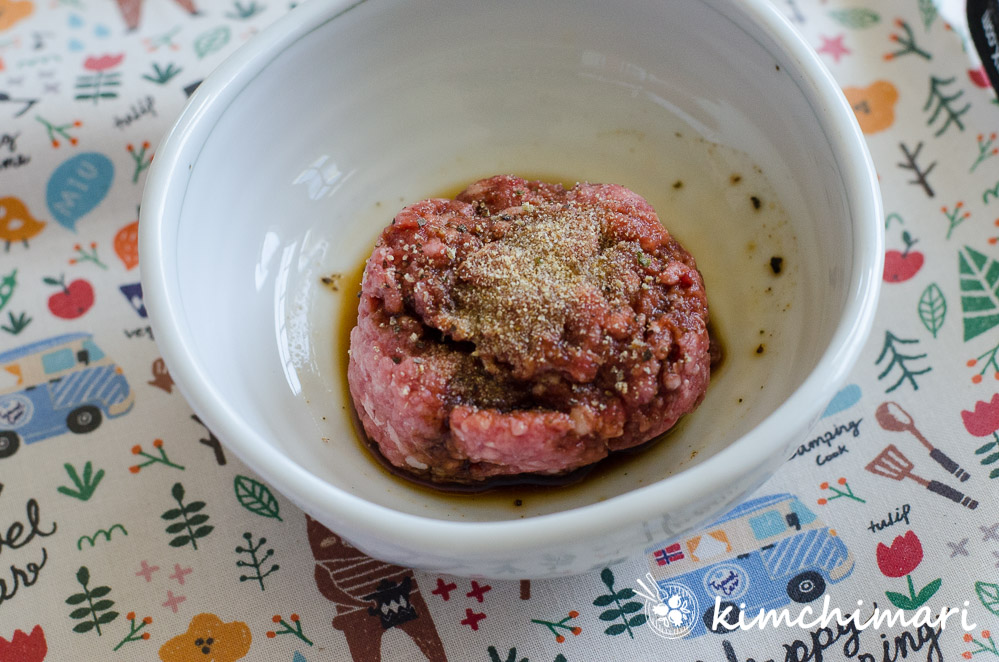
- Season ground beef with soy sauce, cooking rice wine (mirin) and garlic powder or fresh chopped garlic. Mix it well.
- Heat a non-stick frying pan on medium-high heat and saute beef until everything is fully cooked. Break up any big lumps. Set aside.
Spicy Dadaegi 다대기 Sauce –
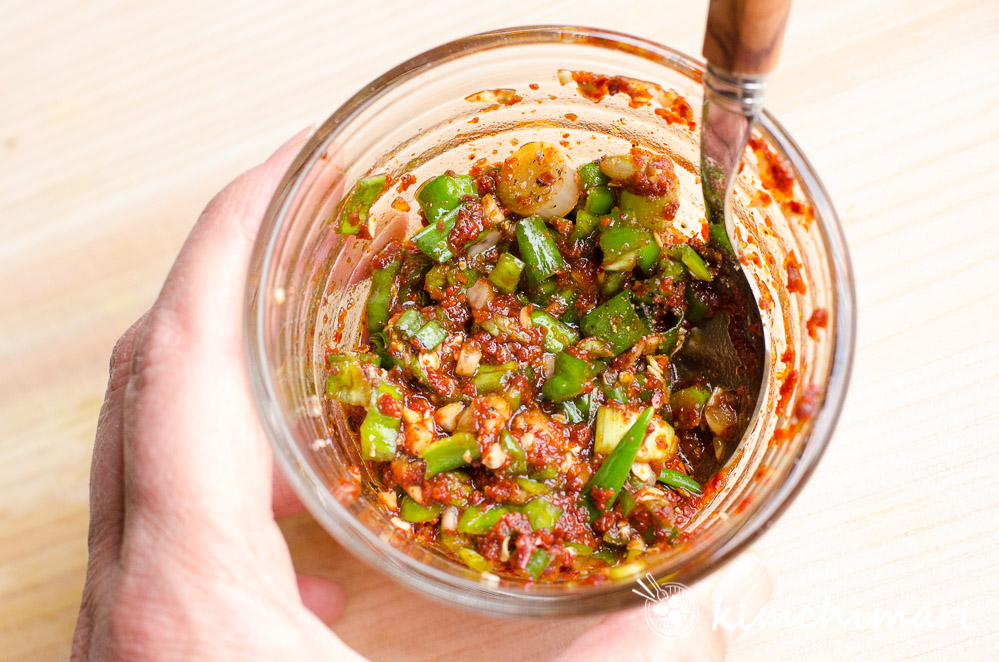
- In a small bowl, add green onions (reserve half to use as topping), chopped chili or shishito peppers and add sesame oil. Mix well and coat everything with oil so they stay fresh longer.
- Add remaining seasonings – soy sauce, vinegar, red chili powder (gochukaru), sugar, garlic and couple dashes of black pepper. Set aside and serve with noodles.
How to make Anchovy Broth Kalguksu noodle soup
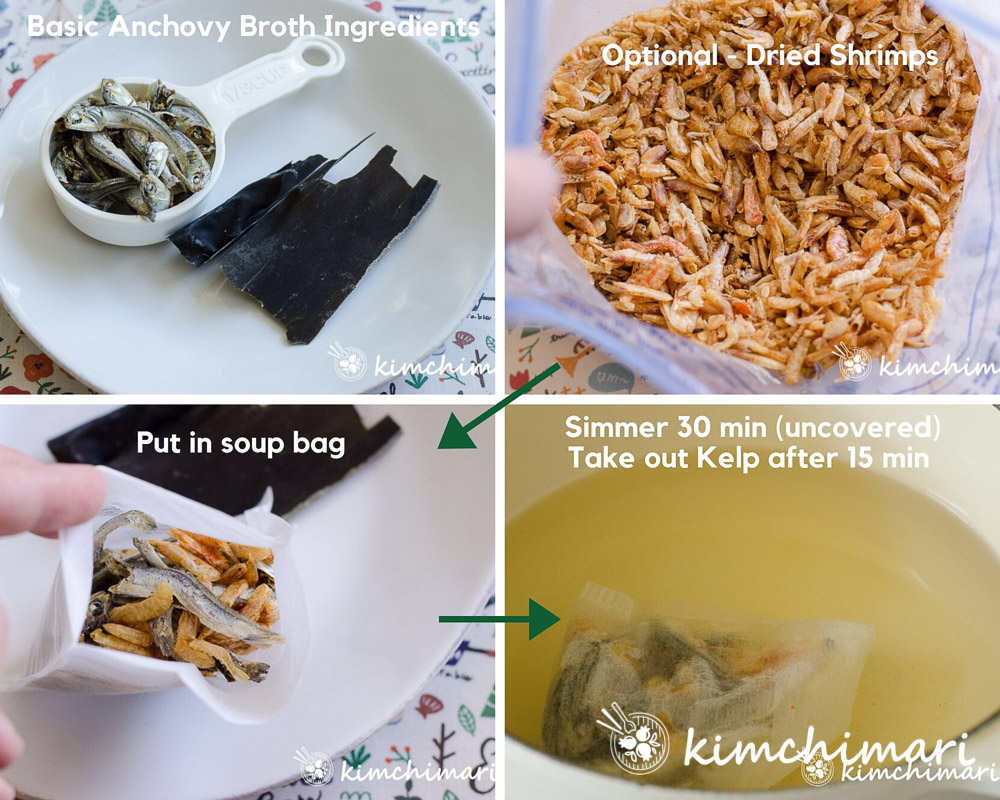
- If making fresh noodles, follow instructions above to make dough.
- Make Anchovy Broth – in a pot, add water, dried soup anchovies (guk myeolchi 국멸치) and kelp (dashima/kombu). Optionally, add dried shrimp. Find different anchovy broth recipes HERE.
- Simmer UNCOVERED, for 30 minutes while you make the noodles. Remove dried Kelp after 15 -20 minutes (esp. when it starts to produce slimy stuff). Turn off heat.
vegetable ingredients for Kalguksu and how to cut and chop them - Prepare vegetables –
- slice onions, cut zucchini, and optionally potato into matchsticks.
- chop all green onions and green chili peppers or shishito peppers.
- chop garlic
- When anchovy broth is done, remove and discard anchovies and kelp.
- Bring anchovy broth to boil. Season broth with guk ganjang (soup soy sauce) and sea salt.
Onions cooking in pot - Once the broth starts to boil, add onions and lower heat back to simmer for 5 minutes until onions start to become translucent.
Kalguksu Noodles cooking in Pot - Turn heat back on to medium-high and now add zucchini and noodles. If using packaged noodles, follow instructions on the package. Add garlic and green onions now or add them later fresh as toppings if you like the stronger taste.
Cooked Kalguksu in Pot - Cook noodles about 3- 5 minutes for homemade fresh noodles and for packaged Kalguksu noodles, follow directions on the package.
Korean Kalguksu – Knife Cut Noodle Soup - Serve noodles and soup in a bowl with the spicy Dadaegi on the side. Top noodle soup with fresh green onions, ground beef topping and optionally fresh chopped garlic and/or green chili peppers. Allow each person to add as much or as little as Dadaegi as they want.
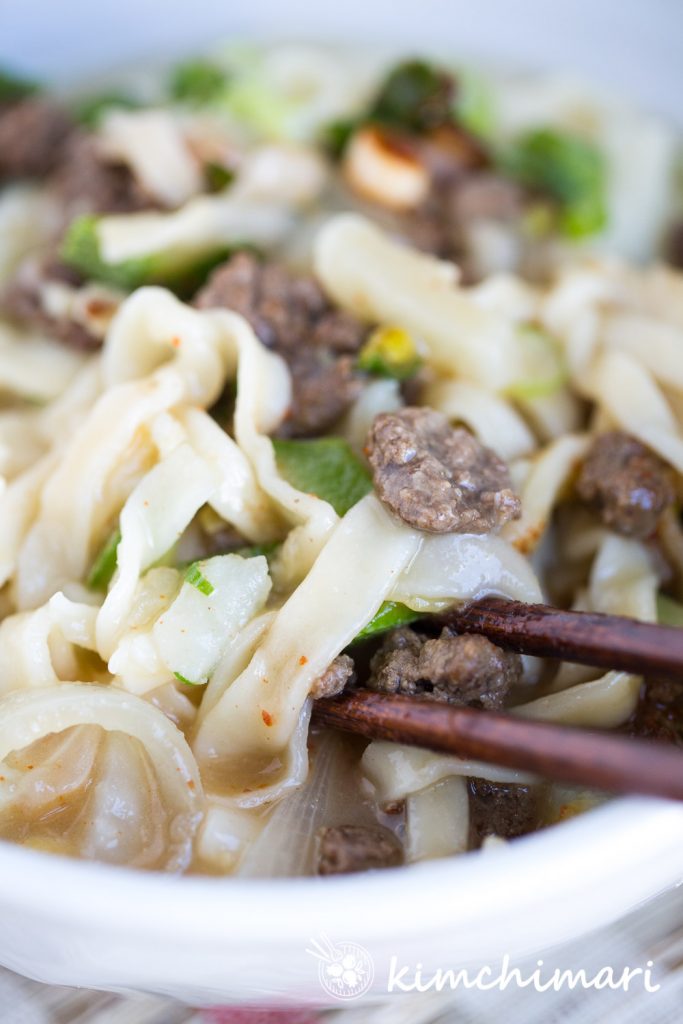
Enjoy it with some Kimchi – especially some Geotjeori or Buchu Kimchi. Recipe for Buchu Kimchi coming soon!
☆ Did you make this recipe? I hope you can give me a 5 star rating below!
You can also FOLLOW ME on YouTube, FACEBOOK, PINTEREST and INSTAGRAM or join my FACEBOOK GROUP to see, ask and share everything about Korean food with others just like you!
Stay safe and sane everyone!!
XOXO ❤️
JinJoo
Kalguksu (Korean Knife-Cut Noodle Soup)
Ingredients
Dough for Knife Cut Noodles (1 serving = 8 oz or 2 cup in volume)
- 1 cup all purpose flour
- 1/4 cup water
- 1.5 tsp water (extra water to make the dough work but as little as possible should be added)
- 1/4 tsp fine salt
Anchovy Soup Broth
- 4 cup water
- 1/3 cup dried soup anchovies
- 1 Tbsp dried mini shrimps (optional)
- 1 piece dashima (kombu) kelp (about 2x3 inch for each piece)
- 1/2 tsp salt (Trader Joe's sea salt)
- 1 tsp Guk Ganjang (Korean Soup soy sauce)
Chicken Broth
- 4 cup chicken broth (fresh home made chicken broth from baeksuk is best but canned broth should also be ok)
Beef Broth
- 4 cup beef broth (my gogiguk recipe will work best but you can also use bone broth)
Soup ingredients
- 2/3 cup zucchini or Korean hobak (matchsticks)
- 1/4 each yellow onion
- 1/3 cup potatoes (matchsticks - optional - can make soup thick)
- 1 each green onion
Beef Topping
- 3 oz Ground Beef (or thin slices of beef, 3 oz = 1/4 cup)
- 1.5 tsp cooking sake or mirin
- 1.5 tsp soy sauce (jin ganjang or regular kikkoman)
- 1/2 tsp garlic (chopped or 1/2 amount in garlic powder)
Yangnyeom Ganjang (Green Chili Sauce)
- 1 Tbsp Jin Ganjang (soy sauce)
- 1.5 tsp Gochukaru (Red Chili Pepper powder)
- 2 tsp green chili pepper (putgochu or Jalapeno) (chopped - substitute shishito peppers (double amount) if you want mild sauce, adjust to your spice level)
- 1 tsp rice vinegar (or white vinegar)
- 1 Tbsp green onion (chopped)
- 1/2 tsp sesame oil
- 1 tsp garlic (chopped)
- 1/8 tsp sugar
- 1/8 tsp black pepper
Instructions
How to make noodles (skip this if you are using store-bought)
- In a bowl, mix flour, salt and water with a spatula and then use your hands to form a ball. Making sure all the flour is incorporated into the dough. My recipe uses less water than most recipes so it may feel like there isn't enough water. The exact amount can change based on how dry your flour is but start with 1/4 cup + 1.25 tsp water per 1 cup of flour and see if you are able to form a dough. But if not, knead for a few times to see if you really need more water and add little bit more water (up to 1 tsp more).
- Once a dough ball has formed, sprinkle some flour on a counter or a board and then transfer the ball onto it. Knead about 10 times to make sure it forms one uniform dough. Cover with a plastic wrap or put in a plastic bag and let it rest for 30 minutes or more. You can also make the dough a day in advance and let it rest in the fridge.
- When it has rested, take out the dough and knead for 2 minutes to warm up the dough. On a floured surface, roll out the dough using a rolling pin until it is about 10x10 inch square or 8x11 rectangle. It doesn't really matter. If the dough sticks, sprinkle some flour on the rolling pin and on the board while rolling. Roll out until it's nice and thin - like you see in the picture.
- Sprinkle flour on the surface of the dough (so it doesn't stick to itself when rolled up) and fold the dough over from one side 4-5 times so you have layers. Cut gently with a knife (if you press hard, they will stick together so be careful) and immediately unfold and loosen the layers so they don't stick to each other. Sprinkle some more flour on the noodles and toss them so they are separated and well coated in flour. Set aside uncovered until you are ready to cook the noodles.
- *** Alternatively, you can use a stand mixer or a food processor to make your dough. But once the dough ball has formed, make sure you knead it by hand before letting it rest.
Beef Topping
- Season ground beef with soy sauce, cooking rice wine (mirin) and garlic powder or fresh chopped garlic. Mix.
- Heat a non-stick frying pan on medium-high heat and saute the beef until everything is fully cooked. Break up any big lumps if there are any. Set aside to top noodles with.
Spicy Kalguksu Dadaegi 다대기 Sauce -
- In a small bowl, add green onions (reserve half to use as garnish later), chopped chili or shishito peppers and add sesame oil. Mix well and coat everything with oil so they stay fresh longer.
- Add remaining seasonings - soy sauce, vinegar, red chili powder (gochukaru), sugar, garlic and couple dashes of black pepper. Set aside and serve with noodles.
How to make Kalguksu noodle soup
- If making fresh noodles, follow instructions above and make dough. Let it rest.
Anchovy Broth (my favorite)
- In a pot, add water, dried soup anchovies (guk myeolchi 국멸치) and kelp (dashima/kombu). Optionally add dried shrimp.
- Simmer UNCOVERED, for 30 minutes while you make the noodles. Turn off heat and let it rest. Let anchovies site in warm water - more flavors develop over time.
Prepare Vegetables
- Slice onions, zucchini, and optionally potato into matchsticks.
- Chop all green onions, garlic and green chili peppers OR shishito peppers. If using shishito peppers, double the amount.
Let's finish! (Kalguksu Noodle Soup should be eaten right away once cooked)
- Remove and discard anchovies and kelp from broth.
- Bring broth to boil. Season broth with guk ganjang (soup soy sauce) and sea salt. Taste. Should be a little bit on the salty side since noodles will make it less salty.
- Once broth starts to boil, add onions and lower heat back to simmer for 5 minutes until onions start to become translucent.
- Turn heat back on to medium-high and add zucchini and noodles. If using packaged noodles, follow instructions on the package on cooking time. Add some chopped garlic and green onions now or later, fresh, as toppings. (I like the stronger fresh flavor as fresh toppings).
- Cook about 3- 5 minutes for homemade fresh noodles. For packaged Kalguksu noodles, follow directions on the package - usually 5-7 minutes.
- Serve noodles and soup in a bowl with the spicy Dadaegi on the side. Top noodle soup with fresh green onions, ground beef and optionally fresh chopped garlic and/or green chili peppers. Allow each person to add as much or as little as Dadaegi as they want.
- Enjoy it with some Kimchi - especially Buchu Kimchi if you have it.
Equipment
- rolling pin (if making handmade noodles)
- soup pot
Tips & Notes:
- Substitute Beef, Chicken, Seafood broth for anchovy broth and you have a totally different dish!
- My favorite ready-made fresh noodles are Pulmuone noodles (pic below) and they need to be cooked 5-6 minutes. If using my fresh homemade noodles, depending on how thin or thick you rolled out the dough, it will take about 3 minutes (for my very thin noodles in the pic) to 5 minutes. Just check the noodles by tasting it after 3 minutes and cook to your liking. Close to 3 minutes if you want al dente style and cook longer if you like softer noodles.
- The nutrition (especially sodium level) level for this recipe is really not accurate as it is hard to calculate the sodium level for broth when the actual ingredients like dried anchovies and shrimps are not eaten.
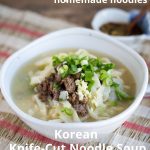
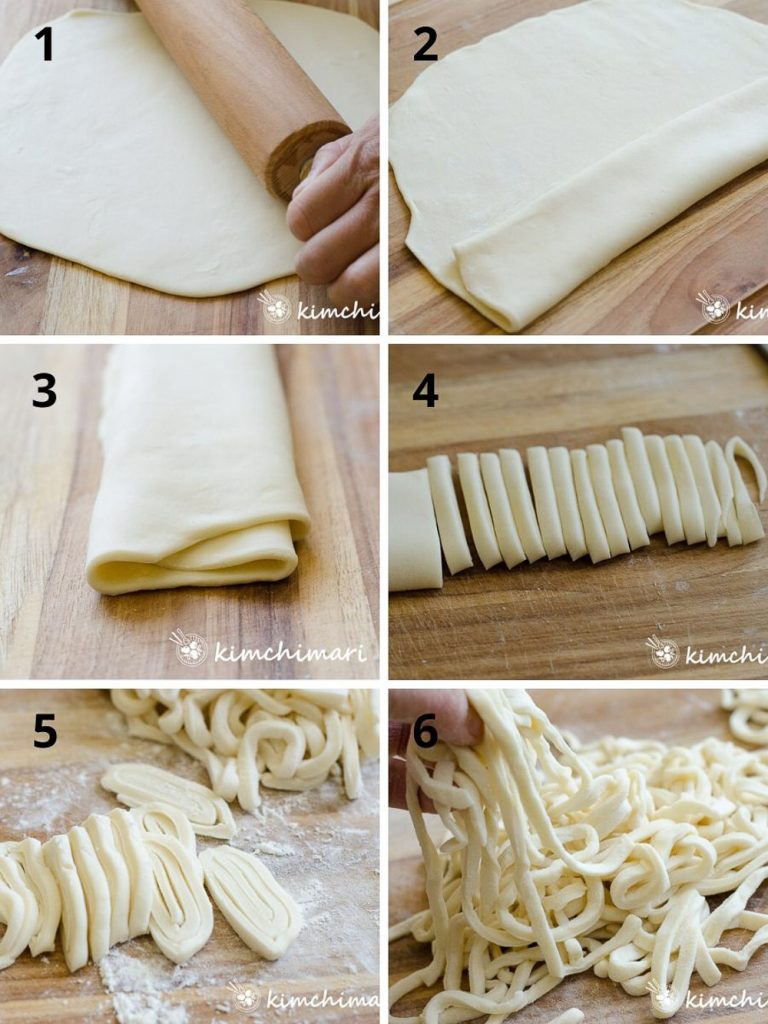
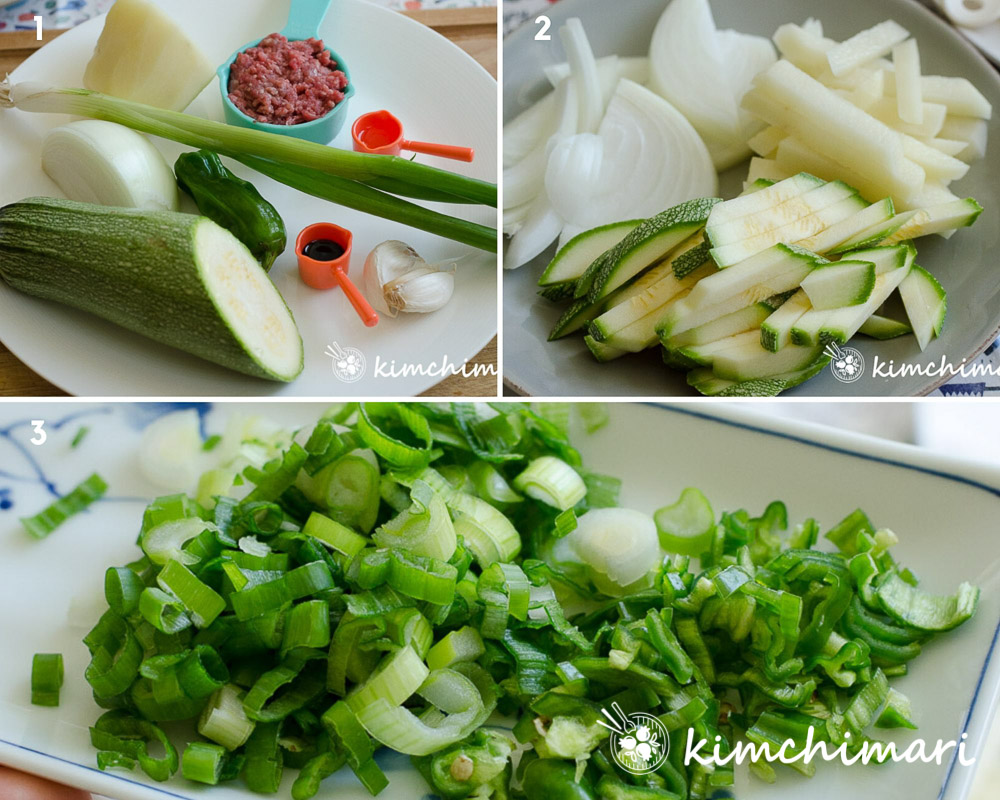
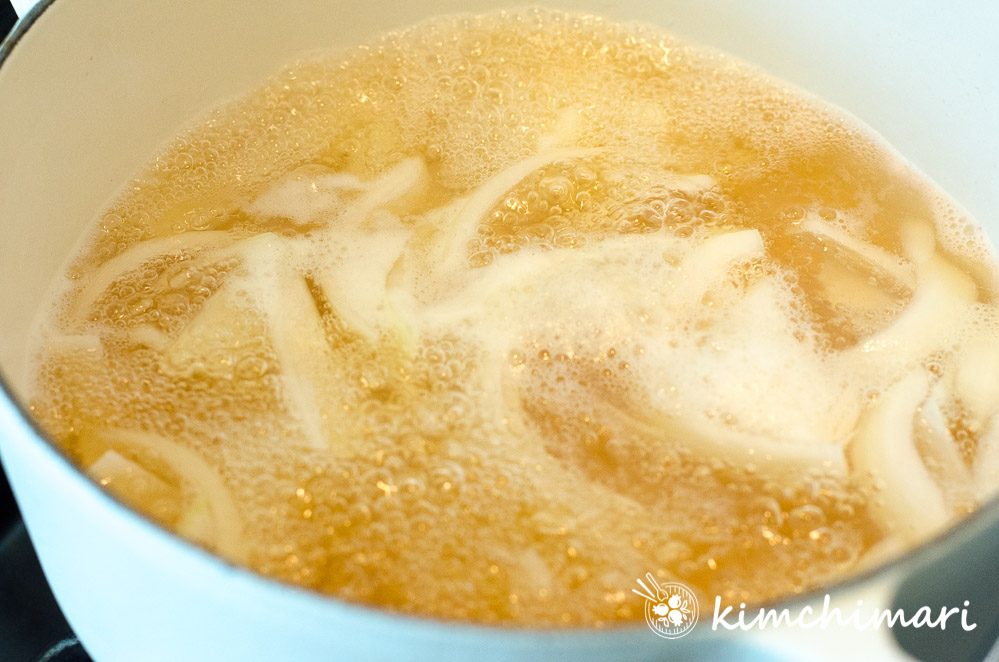
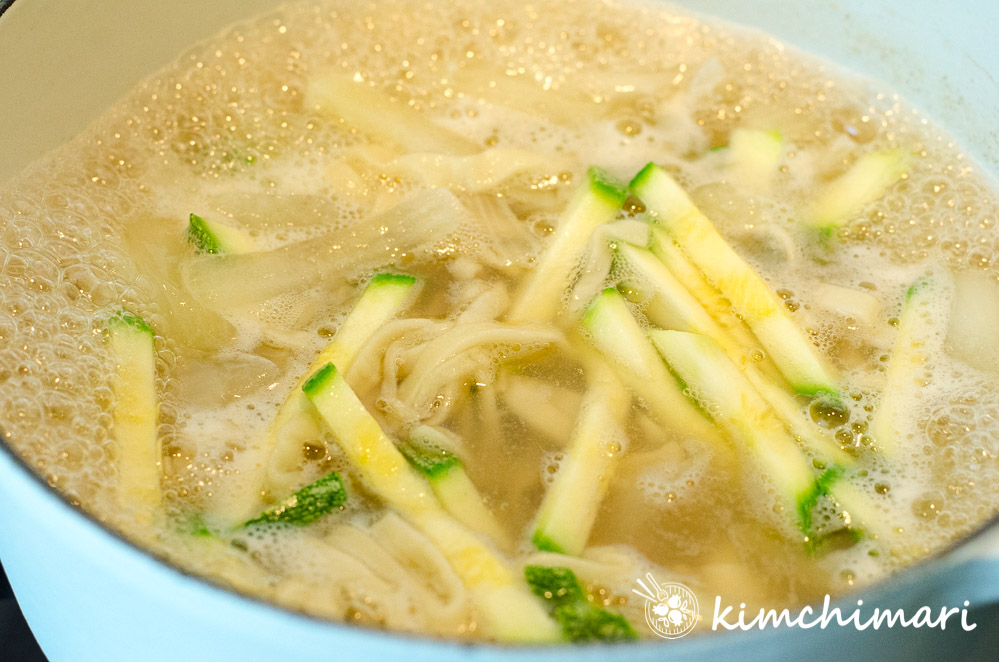
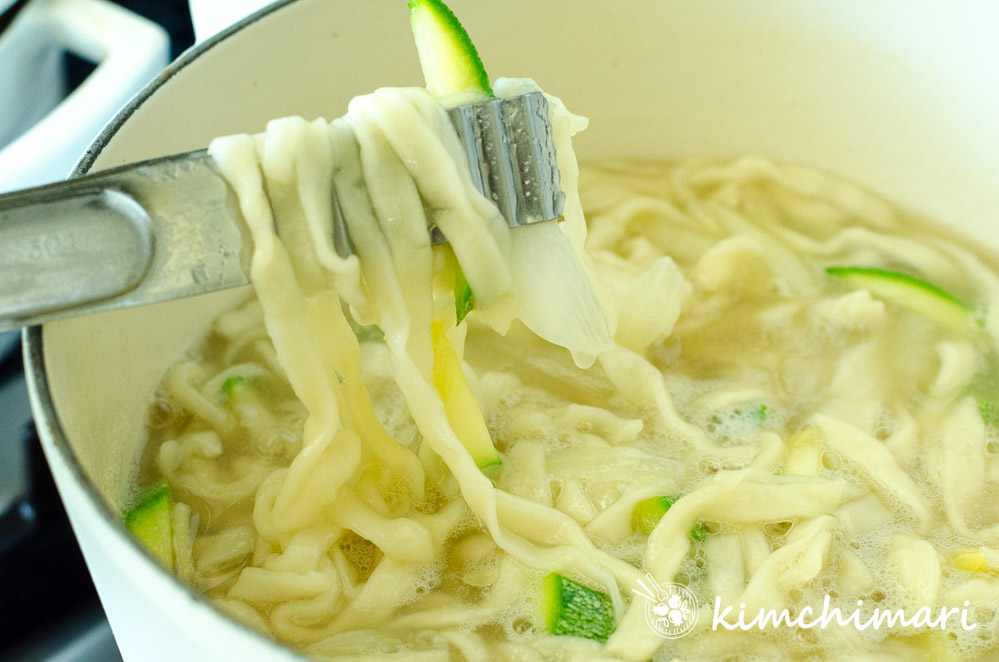
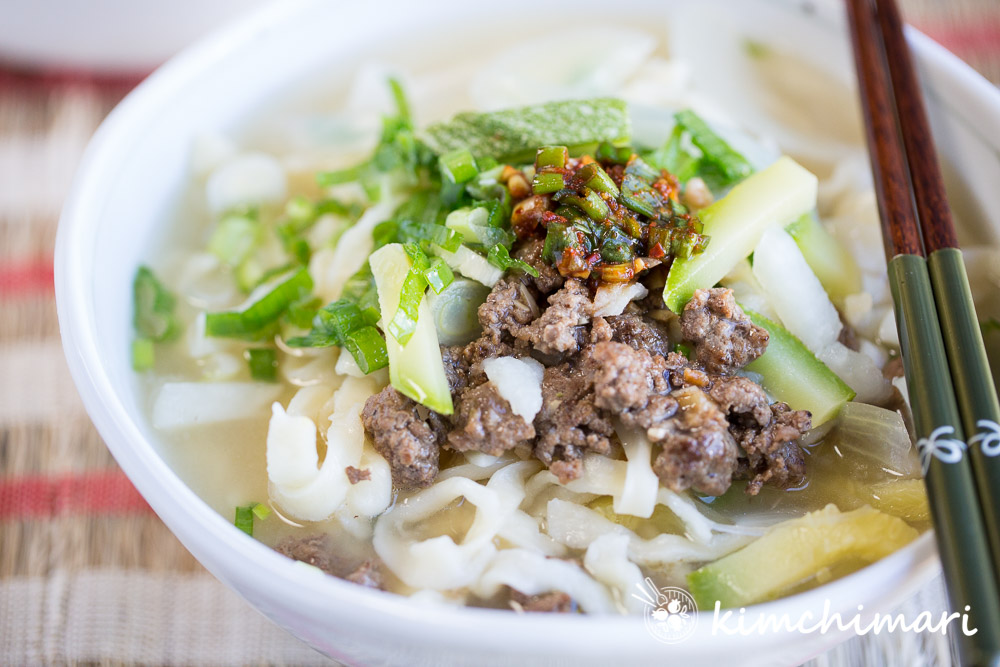
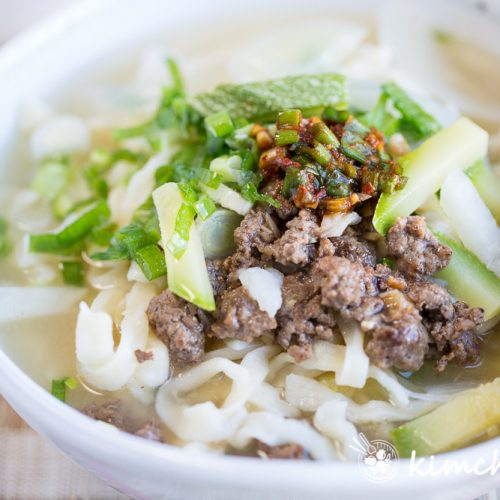
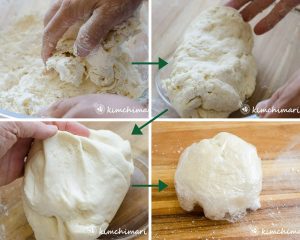
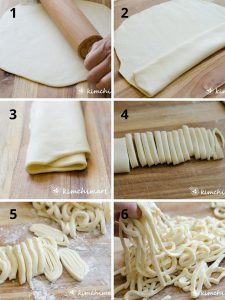

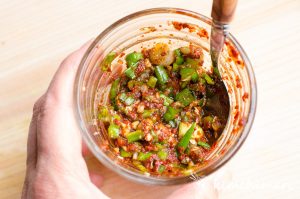
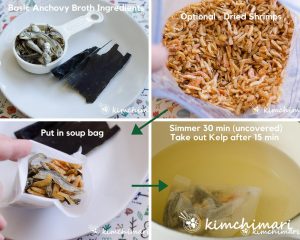
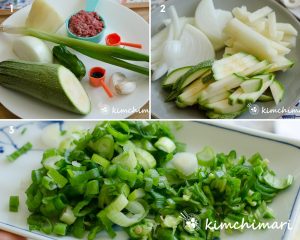
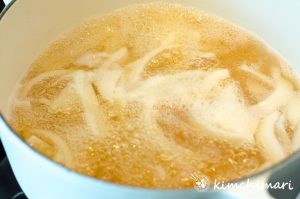
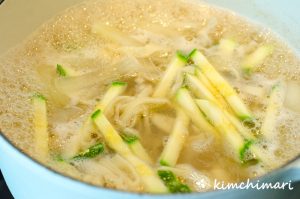
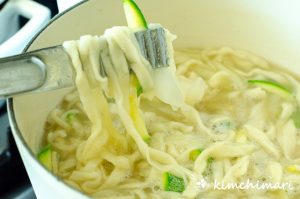
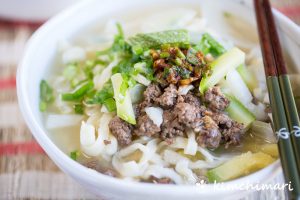
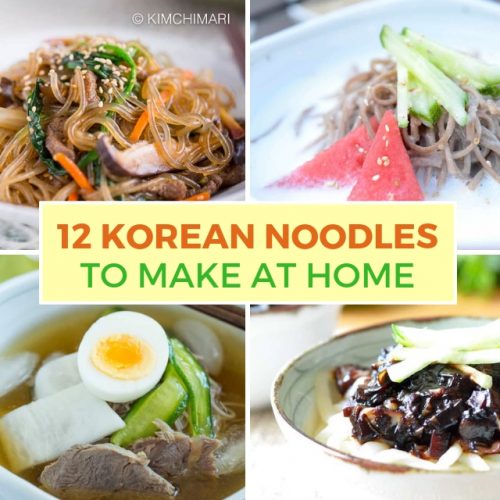
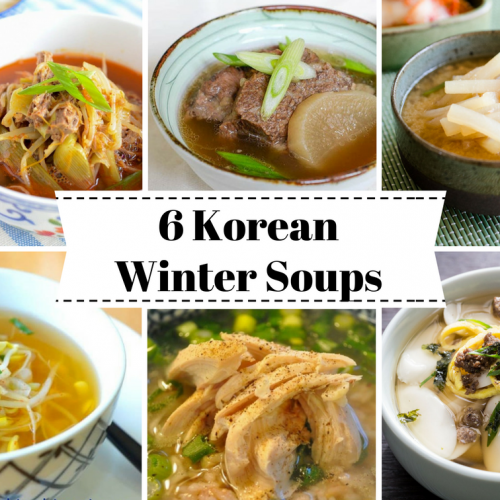
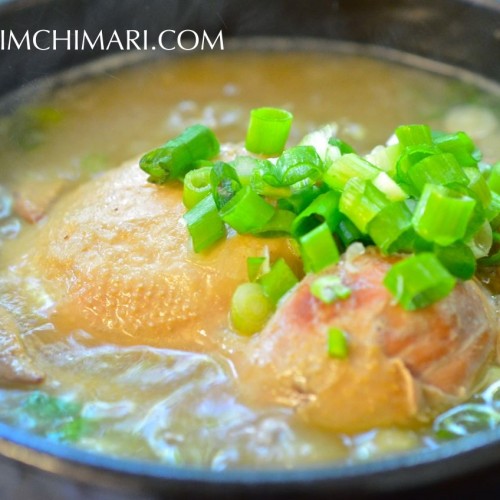
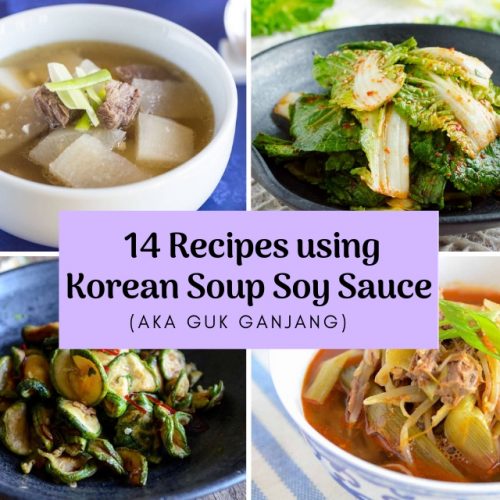
















kalguksu…was searching the meaning of this word after I saw a latest episode of a new K dramas.
when I saw the recipe , it looked like the recipe of a dish “Dal Dhokli” which we make in India …it’s not a noodles but diamond shape pieces of the flour dough which are cooked in the lentil soup or “Dal” as we call in India…it’s a pure veg version.
this made me think that both Korean and Indian or rather all of Asian cooking has similar methods and recipes…what differs is probably the veg and non veg ingredients. Countries which have a colder climate tend to it more of non veg to keep them warm..
delicious! wondering what is the best method to store left over noodles?
Happy to hear that! I did have notes in the post, perhaps you missed it. You can refrigerate dough up to a day ahead and leftover noodles can be stored too but make sure they are dried for 1/2 day and well-floured so they don’t stick together. Cheers!
Hi! What’s the best flour to use for the noodle dough? Should I use bleached or unbleached?
I usually buy unbleached but totally up to you. There’s no difference for the dough whether it’s unbleached or bleached. It’s really up to you what you feel more comfortable eating.
This was always a treat growing up. Your explanation is the most in-depth I’ve come across and is almost exactly how my late aunt made it. My mom mostly made dak kalguksu but I prefer anchovy broth, zucchini, onions & potatoes.
It’s also the way I make sujebi, just less work w/the dough + an egg dropped in.
Thank you for the great info and great recipe!
Thank you so much for your kind feedback! My mom made Dak Kalguksu mostly too! But anchovy broth is my husband’s favorite. And yes, Sujebi!! OMG I haven’t made that in ages!! I need to make that soon.